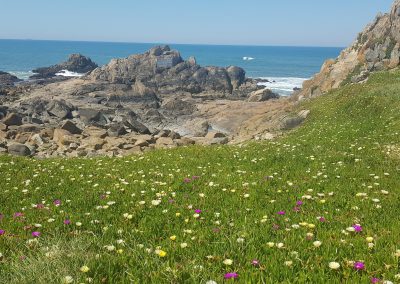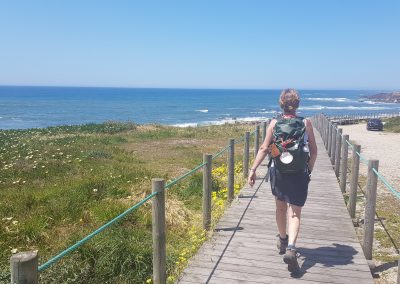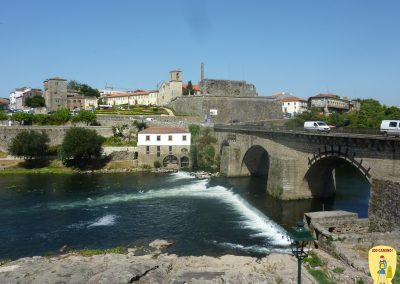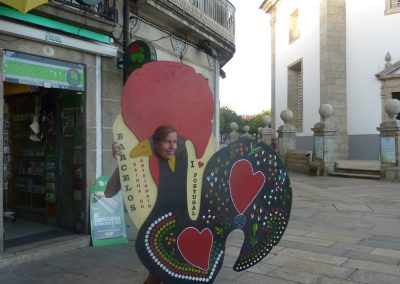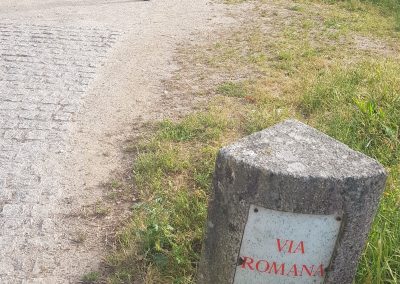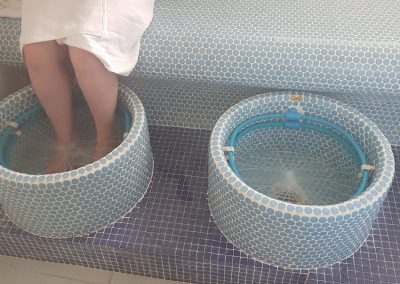
Camino Portugués
We accompany you on your first steps on your way to Santiago de Compostela, in small groups of a maximum of ten persons. We follow the path of the pilgrims towards Santiago, respecting your own rhythm.
2021 and 2022 were Holy Years. The Holy Year is celebrated when the 25th of July, the feast of St. James the Apostle, falls on a Sunday. Just think that every century, this happens only 14 times. During the Holy Year, the Pilgrim’s Mass is celebrated more frequently, as well as the use of the famous Botafumeiro in such celebrations. The next holy year will be in 2027.
Many pilgrims still use this pilgrimage as a way to find some answers or simply take some time away from their overly busy lifestyle, or to balance their life.
Departures
2025
- 15/04-28/04/25
Day 0: Porto (for Camino Portugues Light scroll to day 7)
We stay at Porto’s historical heart : the Ribeira. This waterfront bairro positively insists you lose yourself amongst the maze of narrow streets and seek out some of the city’s most cherished architectural treasures. In fact, so rare and precious are the buildings that make up this venerable neighborhood that UNESCO declared it a World Heritage Site.
Day 1: Porto – Vila do Conde (21,6 km)
We pass by the the Cathedral Sé in Porto and we start our camino in Matosinhos along the beach at the Atlantic coast. We pass the famous fish market. By crossing the bridge “Ponte Móvel”, we symbolically start our first day.
We now join the wooden boardwalks along the beautiful coastline. We pass by the lighthouse along the Costa Negra, Remembrance Beach and Obelisk. Before we arrive in the delightful town called Vila do Conde, we have lunch in one of the seaside villages. In Vila do Conde we have the opportunity to visit the Capela do Socorro or the maritime museum. From the Convento de Santa Clara, we are rewarded with fine views of the town and the remains of a remarkable aquaduct. We will not forget to sample some delicious seafood.
Day 2: Vila do Conde – Barcelos (15,9 km) – ↗237m↘274m
Due to a dangerous road crossing the Camino Portugues, we start our tour by transfer to São Pedro de Rates.
By avoiding the busy and dangerous roads, we arrive early at São Pedro de Rates. Right at the entrance of the town we see the Romanesque church that is well worth a visit. We encounter quiet country lanes, mostly screened by eucalyptus and pine woods, into Barcelos.
We enter Barcelos crossing a 14th century bridge. This town of Roman origins, located on a hill above the river Cávado, was the seat of the Counts of Barcelos until the 15th century. Today, it is best known for its’ pottery, most notably the Galo de Barcelos, which is also a symbol of Portugal. Man-sized cockerels are also on display all over town.
Day 3: Barcelos – Vitorino dos Piães (21 km) – ↗402m↘344m
This is one of the most beautiful walks. We have the natural landscape to lift our spirits and then we follow lovely pathways through vineyards and woodland, through the peaceful Neiva valley. We spend the night in Vitorino de Piães.
Day 4: Vitorino dos Piães- Ponte de Lima (12 km) – ↗176m↘261m
Today we walk through the Lima valley and arrive in Ponte de Lima, the oldest town in Portugal which is named after the bridge that crosses the river Lima. This is a delightful market town that retains a sleepy medieval atmosphere. The region is renowned for the ‘vinho verde’ or green wine it produces. There is a Garden Festival held from May to October. During this festival, there are twelve different gardens that are open to the public to view. We make sure to visit these visually enticing gardens when walking through Ponte de Lima.
Day 5: Ponte de Lima – Rubiães (18 km) – ↗561m↘368m
This stage marks our steepest accumulative climb up the Labruja valley, with its highest point at Alto da Portela Grande (alt. 410m). Here your walking poles come in handy. There are also numerous chapels and wayside crosses where pilgrims to Santiago have placed stones to mark their passage. We spend the night in Rubiães.
Day 6: Rubiães – Tui (19,3 km) – ↗332m↘496m
Today is a special day as we start the walk into Portugal, and end up in Galicia, Spain! The landscape here is like the rest of Galicia: green and hilly. It is no surprise that we start by walking down towards Rio Coura before starting a long climb up to Alto Sao Bento da Porta Aberta. Then, it is a steep descent to Fontoura before continuing towards Rio Minho, the natural and modern border between the two countries. We walk past the historic old walled town of Valença. Here, you want to visit the fortress. On your way to Tui, you will cross the old international bridge built in 1879 over the Minho River. We adjust our watches to the Spanish time zone + 1. Tui is a well-preserved medieval town. Worth a visit is the Catedral de Santa Maria. The 12th-century cathedral will leave you with a lasting memory.
Day 7: Tui – O Porriño (17,3 km) – ↗170m↘195m – Start Camino Portugues light
From Tui, most of this stage is along quiet country roads and woodland paths that follow the rio Louro valley. We then arrive in the town of O Porriño where we will spend the night. We look forward to sampling some of the Galcian cuisine.
Day 8: O Porriño – Redondela (14,9 km) – ↗248m↘256m
On this stage, we will have the pleasure of seeing the church of Santa Eulalia del Monte and the Pazo de los Marqueses in the parish of Mos. These are some of the most beautiful examples of Galician architecture in this region. We will continue our journey through peaceful forest paths. Around Monte Cornedo, we are rewarded by our first views of the sea – the beautiful Ria de Vigo. We then arrive at the convent of Villavella in the city of Redondela where we will spend the night.
Day 9: Redondela – Pontevedra (18,1 km) – ↗469m↘472m
We hike through the mixed forest around Alto de Lomba before dropping down again to the sea at Arcade. Reaching the historic site of Ponte Sampaio, the Camino crosses the Verdugo River. During the War of Independence, Napoleon’s army suffered one of its’ greatest defeats in Galicia at this bridge. We then start the second uphill stretch of the day. We climb the ancient stone paths of the Verea Vella da Canicouva to the next high point around the Cruceiro Cacheiro before descending finally to the provincial capital of Pontevedra. Pontevedra has a lot to offer. At the heart of it’s modern suburbs is a delightful medieval core zona monumental. Here we will see the sanctuary of “La Virgen Peregrina” or Pilgrim Virgin, patroness and symbol of the city. The 18 th century Baroque style chapel has a floor plan in the shape of a scallop shell. Praza de Leña is the most beautiful square in the town.
Day 10: Pontevedra – Caldas de Reis (21,6 km) – ↗290m↘289m
Today you will pass through the villages of Alba, A Portela and Briallos. In Alba, the church of Santa Maria de Alba is beautiful. In A Portela, you can find the church of San Mamede . We will walk through vineyards, small rural hermitages and forests filled with chestnut, pine and eucalyptus trees. Caldas de Reis is well known for its hot springs and it sits at the confluence of Bermaña and Umia rivers. Rest your feet in the hot springs. We will spend the night at Caldas de Reis.
Day 11: Caldas de Reis – Padrón (18 km) – ↗340m↘370m
At this stage you will leave the province of Pontevedra and enter the province of A Coruna by crossing the bridge over the Ulla River in Pontecesures. Our stage ends in the emblematic town of Padrón. This is the place where, according to tradition, the stone boat containing the remains of the Apostle arrived from Palestine. This town is the place where the famous Padrón peppers originate. Even today, these peppers are cultivated in this area in large number-, annually, 15 tons are produced here. In the evening we sample the famous Padrón peppers at Padrón (with one in 30 being chilli-hot).
Day 12: Padrón – Santiago de Compostela (24,9 km) – ↗512m↘273m
The Camino passes through many small villages and hamlets before arriving at the Baroque sanctuary of A Esclavitude. On a hilltop to the left stand the mysterious abandoned ruins of the hill fort Castro Lupario. We come to the oldest wayside crosses in Galicia. As we near Agro dos Monteiros, it is now possible to see the towers of the cathedral of Santiago. Finally the Camino passes by the ruins of a castle known as A Rocha Vella, before entering the city of the Apostle. Being ‘fumigated’ by the Botafumeiro in the Santiago Cathedral, for many pilgrims, is the formal end of their journey. Seeing the swinging through the Church of the giant censer and touching the image of the Apostle Santiago. With our Compostela now in our possession, we finish off the evening with a last communal meal.
Bom caminho!

What is included in your trip?
pilgrim’s kit containing pilgrim passport, scallop shell, packing list
my experienced guidance – we have a daily briefing at dinner
transport of your luggage – limited to one transport bag during the walk
accommodation on twin sharing basis, single room upon request (extra charge)
food: breakfast (dinner is around 12-15 EUR)
on arrival in Santiago your Compostela
a unique and amazing experience you will never forget!
The groups consist of up to ten people. You can socialise as much or as little as desired – some people like to walk in groups, others prefer to hike alone. It’s your choice- it is your Camino!
Number of overnight stays: 13/7 (light)
Number of km to be hiked: 222,6 km/114.8 km (light)
Price: 1.699 EUR/1060 EUR (light)
Fitness niveau: ![]()
![]() People with a basic level of fitness can participate
People with a basic level of fitness can participate
Excluded in the price:
Flights and travel insurance are not included. Do not hesitate to refer to me for any travel-related information.
The best way to travel to Porto, Portugal:
Porto airport in Portugal is well connected by different budget airlines. Please refer to me for any travel-related information.
“To arrive in Santiago like a young person, begin the Camino like an old man.”
What are you waiting for?

Camino's & Digital Detox:
Follow Go-Camino
All text and images © Copyright Go Camino and Elvira Rog.
The Go Camino logo, "Go Camino", "Digital Detox Camino, "Friese Camino" , "Camino Vino", "Camino Original" and "Camino Spiritual" are trademarks and/or service marks and/or registered trademarks of Go Camino and Elvira Rog in the Benelux and/or Spain and/or other countries.




